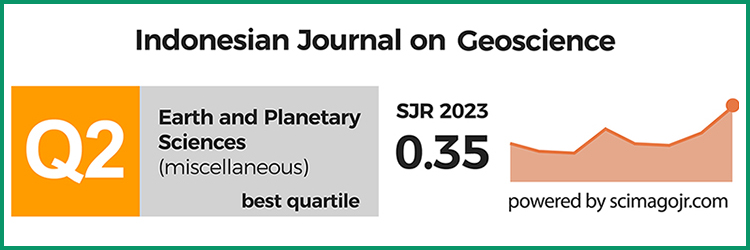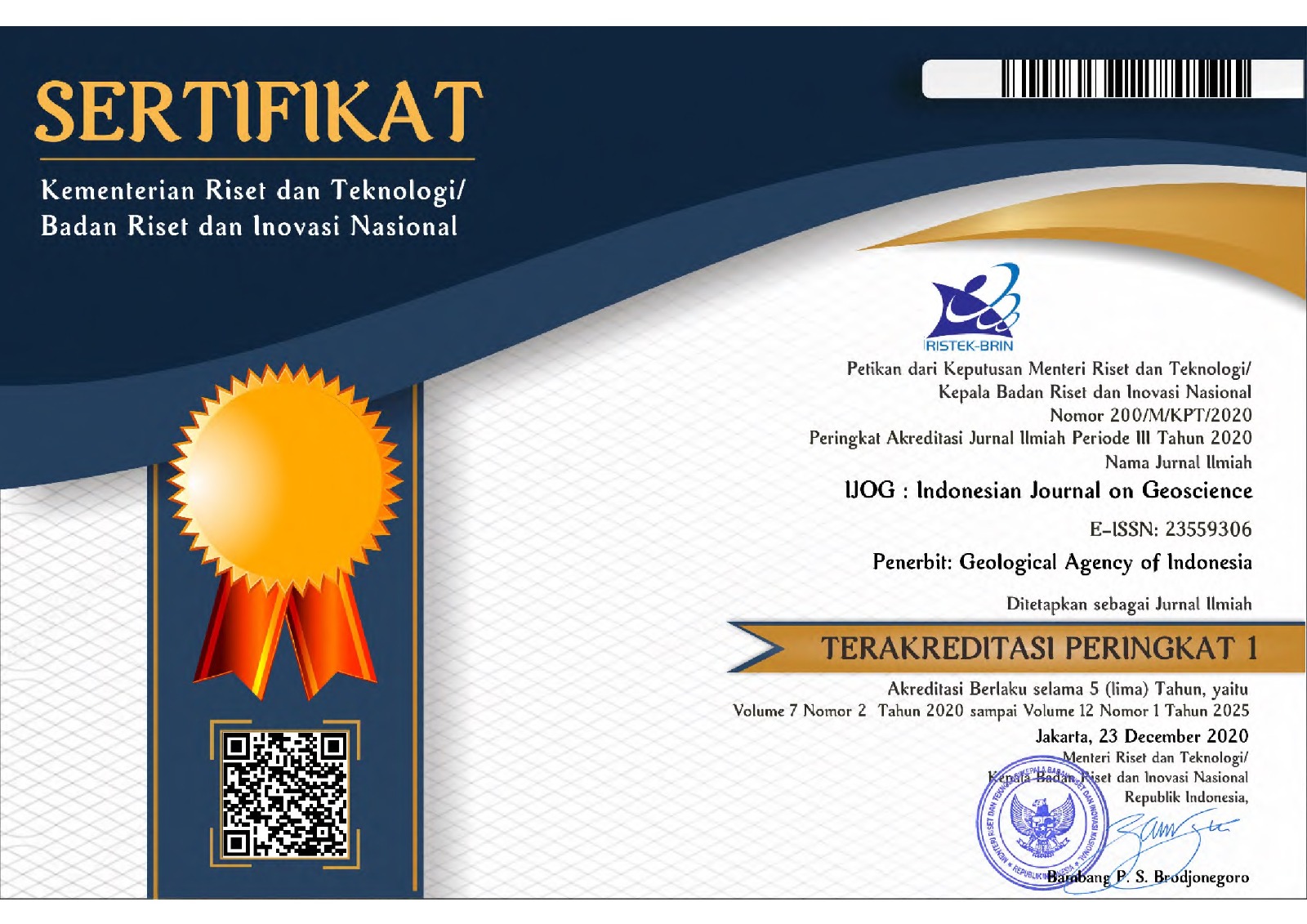Analisis stratigrafi awal kegiatan Gunung Api Gajahdangak di daerah Bulu, Sukoharjo; Implikasinya terhadap stratigrafi batuan gunung api di Pegunungan Selatan, Jawa Tengah
DOI:
https://doi.org/10.17014/ijog.4.3.157-165Keywords:
volcaniclastic rocks, composite volcano, caldera explosion, construction period, destruction phase, stratigraphy, Southern MountainsAbstract
https://dx.doi.org/10.17014/ijog.vol4no3.20091
Generally, Tertiary volcanisms in the Southern Mountains, Central Jawa were started with the formation of pillow lavas having basalt to basaltic andesite in composition. This initial stage volcanism developed into a construction period of composite volcanoes that consist of alternating basaltic to andesitic lava flows, breccias, and tuffs. The construction period could be followed by a destructive phase, producing pumice-rich pyroclastic breccias, lapillistones, and tuffs of high silica andesite to dacite, or even rhyolite in composition. A stratigraphic measuring section at Bulu area, Sukoharjo Regency, presents an alternat- ing fine-grained andesitic volcaniclastic material and some limestones, with the total thickness is 143.33 m. The thickness of bedded volcaniclastic material tends to be thickening upward from 35 m until 90 m. The grain size of the volcaniclastic material also tends to be coarsening upward from clay size through silt and fine sand to coarse sand and granules. Paleontological analysis on fossils contained in the lime- stone gives an age of Early Miocene (N7 - N9). The volcaniclastic rocks is conformably overlain by the Mandalika Formation, comprising alternating andesitic breccias, lavas, and tuffs. These data imply that the fine-grained volcaniclastic material is an initial product of the construction period of Gajahdangak Volcano in the area, that formed the Mandalika Formation. This Formation is overlain by the Semilir Formation, composed of pumice-rich pyroclastic breccias and tuffs with dacitic composition. This as- sociated volcanic rock reflects a product of a caldera explosion or a destructive phase. Based on the characteristics of lithology of volcanic products from the initial stage, to a construction and destruction period, and compiled age data, the Southern Mountains represent formal volcanic rock units that are able to be divided into many formations.
References
Akmaluddin, Setijadji, D.L., Watanabe, K., dan Itaya, T., 2005. New Interpretation on Magmatic Belts Evolution During the Neogene – Quartenary Periods as Revealed from Newly Collected K-Ar Ages from Central-East Java, Indonesia. Prosiding JCS, HAGI XXX-IAGI XXXIV- PERHAPI XIV, Surabaya.
Bronto, S., 2007. Fosil gunung api di Pegunungan Selatan Jawa Tengah. Seminar dan Workshop “Potensi Geologi Pegunungan Selatan dalam Pengembangan Wilayah”, Kerja sama PSG, UGM, UPN “Veteran”, STTNAS dan ISTA, Yogyakarta, 27-29 Nov.
Bronto, S., Bijaksana, S., Sanyoto, P., Ngkoimani, L.O., Hartono, G., dan Mulyaningsih, S., 2005. Tinjauan Vulkanisme Paleogen Jawa. Majalah Geologi Indonesia, 20, (4), h.195-204.
Cas, R.A.F. dan Wright, J.V., 1987. Volcanic Successions, Modern and Ancient, Allen & Unwin, London, 528 h.
Fisher, R. V. dan Schmincke, H. M., 1984. Pyroclastic Rocks. Springer-Verlag, Berlin, 472 h.
Fisher, R. V. dan Smith, G. A., 1991. Volcanism, Tectonics and Sedimentation; Sedimentation In Volcanic Settings. Dalam: Fisher, R. V. dan Smith, G. A., (Eds.), SEPM Special Edition, (45), Tusla, Oklahoma, USA, h.1-5.
Gill, J.B., 1981. Orogenic Andesites and Plate Tectonics, Springer – Verlag, 390 h.
Hartono, G. dan Syafri, I., 2007. Peranan Merapi Untuk Mengidentifikasi Fosil Gunung Api Pada “Formasi Andesit Tua”: Studi Kasus Di Daerah Wonogiri. Geologi Indonesia: Dinamika dan Produknya, Publikasi Khusus, 2 (33), Pusat Survei Geologi, Bandung, h. 63-80.
Hartono, G., 2000. Studi Gunung api Tersier: Sebaran Pusat Erupsi dan Petrologi di Pegunungan Selatan Yogyakarta. Tesis S2, ITB, 168 h. Tidak diterbitkan.
Hartono, G., Sudradjat, A., dan Syafri, I., 2008. Gumuk Gunung Api Purba Bawah Laut Di Tawangsari – Jomboran, Sukoharjo – Wonogiri, Jawa Tengah. Jurnal Geologi Indonesia, 3 (1), h. 37-48.
Lorenz, V. dan Haneke, J., 2004. Relationship between diatremes, dykes, sills, laccoliths, intrusive-extrusive domes, lavas flows, and tephra deposits with unconsolidated water-saturated sediments in the late Variscan intermontane Saar-Nahe Basin, SW Germany. Dalam: Breitkreuz, C. dan Petford, N., (Eds.), Physical Geology of High-Level Magmatic Systems, Geological Society of London, h.75-124.
Martodjojo, S., 1984. Evolusi Cekungan Bogor, Jawa Barat, Disertasi Doktor, Fakultas Pasca-Sarjana, ITB, Indonesia.
Ngkoimani, L., 2005. Magnetisasi Pada Batuan Andesit di Pulau Jawa serta Implikasinya Terhadap Paleomagnetisme dan Evolusi Tektonik, Disertasi Doktor, Fakultas Pasca Sarjana, ITB, Indonesia, 110 h.
Priadi, B. dan Mubandi, ASS., 2005. The Occurrence of Plagiogranite in East Java, Indonesia. Prosiding JCS, HAGI XXX-IAGI XXXIV-PERHAPI XIV, Surabaya.
Rahardjo, W., Sukandarrumidi, dan Rosidi, H. M. D.,1977. Peta Geologi Lembar Yogyakarta, Jawa, skala 1:100.000. Pusat Penelitian Pengembangan Geologi, Bandung.
Samodra, H., Gafoer, S., dan Tjokrosapoetro, S., 1992. Peta Geologi Lembar Pacitan, Jawa, skala 1:100.000. Pusat Penelitian Pengembangan Geologi, Bandung.
Simkin, T., Siebert, L., McClelland, L., Bridge, D., Newhall, C., dan Latter, J.H., 1981. Volcanoes of the World: A Regional Directory, Gazetteer, and Chronology of Volcanism During the Last 10,000 Years. Stroudsburg, Penn: Hutchinson Ross, 240 h.
Soeria-Atmadja, R., Maury, R. C., Bellon, H., Pringgoprawiro, H., Polve, M., dan Priadi, B., 1994. The Tertiary Magmatic Belts in Java. Journal of SE-Asian Earth Sciences, 9, (1/2), h 13-27.
Surono, Sudarno, I., dan Toha, B., 1992. Peta Geologi Lembar Surakarta – Giritontro, Jawa, skala 1:100.000. Pusat Penelitian Pengembangan Geologi, Bandung.



















